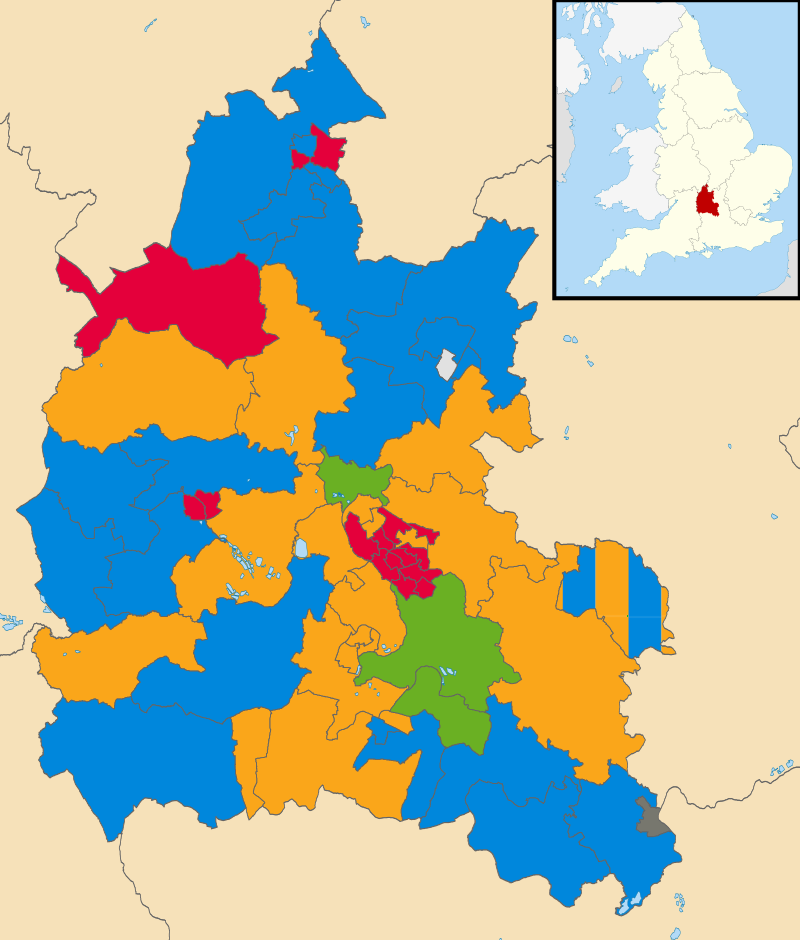Labour launches no confidence motion in OCC

The Labour group on Oxfordshire County Council has launched a motion of no confidence in the council’s Liberal Democrat leadership.
Oxfordshire’s county councillors – all 63 of them – meet seven times a year. The next “full council” meeting is this Tuesday.
After the official business, the floor is open for councillors of all parties to submit their own motions. There’s never enough time for every motion to be debated, so the order is rotated, with each party getting a go at first place. This time, it’s Labour’s turn – and they’ve chosen to use their slot for the nuclear option of a no-confidence motion.
The background

Oxfordshire’s electoral map since 2021 has been a riot of colour – but on the BBC coverage map, it lit up grey. That’s broadcaster shorthand for “No Overall Control”, where no single party has a majority. The Liberal Democrats and Greens joined to form the largest group, with the Conservatives close behind, and Labour in third.
At first, a “rainbow coalition” of LibDems, Labour, and Greens took control. Cabinet posts were divvied out between the parties, with the LibDems’ Liz Leffman as leader, and Labour’s Liz Brighouse taking the crucial education portfolio.
This lasted until September 2023, when an Ofsted report into Oxfordshire’s special needs provision [SEND] lambasted the council. “There are widespread and/or systemic failings,” it began. “For most children, their experience is one of confusion and delay. There are lengthy waiting times for help and leaders have not acted effectively enough. Too many children and young people do not receive the right help until they are close to crisis point.” It would be hard to conjure up a more damning report.
Damian Haywood, an Oxford Labour councillor whose son has special educational needs, resigned in protest. He wrote: “The fundamental failure of the [Labour] party to address the concerns identified comes into conflict with my values and morals. The party’s behaviour is self-serving and contrary to the needs of […] the children who have been failed.”
Liz Leffman, as council leader, asked Liz Brighouse to move to another post. She refused, and Labour chose to quit the coalition entirely. Since then, the council has been run by the LibDems and Greens alone, a “minority administration” that can be voted out if Labour and the Conservatives agree to work together.
Labour’s motion
It is Liz Brighouse, as leader of the Labour group, whose name is on Tuesday’s no confidence motion. The motion puts special education front and centre:
This Council no longer has confidence in the Leader of the Council.
This Council records its particular failure to:
1. Keep members and parents abreast of improvements to its SEND provision following last year’s Ofsted-CQC determination;
2. Its stance towards the Housing Infrastructure and Growth (‘HIF’) deals that have eventuated in an expensive and unnecessary public enquiry; and
3. Its perceived conflict of interest on the lease of ‘the Triangle’ to OUFC.
It then goes on to talk about “major transport changes in Central Oxfordshire… Public consent for these schemes is absolutely essential”, and accuses the LibDem/Green administration of being “far too ready to engage in deflection tactics and victim-blaming, rather than engage with solutions”.
It concludes: “This Council resolves that the current Leader of the Council is removed.” There is no love lost between Liz Brighouse and Liz Leffman, but this is not a purely personal battle. Control of a county council comes through the Leader. If you vote out the Leader, you vote out the council. Labour’s motion is one of no confidence in the entire LibDem/Green administration.
The vote


Let’s go through what will happen on the day.
The political makeup of Oxfordshire County Council right now is:
- LibDem/Green group: 23 councillors (=20 LD + 3 Grn)
- Conservative group: 20 (=19 Con + 1 Ind)
- Labour group: 14
- Independent Voice of Oxfordshire: 3
- Other independents: 3 (one ex-Lab, two ex-Con)
Labour’s motion begins “This Council no longer has confidence in the Leader of the Council”. You could imagine the Conservatives voting for this. (It’s not a given – they may well decide that Labour is “playing games” and choose to abstain.)
Taken together, Conservative and Labour votes are enough for a majority. So if the motion passes, then what next? The Clarion has spoken to councillors and others with knowledge of the procedure, and this is our understanding:
When a leader is “removed from office by resolution of the Council”, OCC’s constitution [4.1/3] says an election should immediately take place:
In the case of (c) the election to fill the vacancy should occur, where possible, at the same meeting at which the resolution removing the leader is passed. The newly elected leader will remain in office for the remaining term of the Council subject to paragraphs 3(a) to (c).
There is nothing in the constitution stopping the LibDem/Green group from simply re-nominating Liz Leffman, and this is what we assume would happen.
Labour would then nominate their candidate. The Conservatives may also nominate one – or again, they may decide this is all “playing games”.
The election then takes place. OCC’s constitution [3.1/17.8] explains what happens:
Where a vote is required on an election or appointment and two persons are nominated, the Chair shall call for an electronic vote on the first nomination, followed by an electronic vote for the second nomination. No member shall vote for both nominees.
Where a vote is required on an election or appointment and more than two persons are nominated the following procedure shall apply:
(i) members will be invited to vote for one of the nominees;
(ii) if one nominee secures an absolute majority of those present and voting, s/he shall be declared elected/appointed;
(iii) if no nominee secures an absolute majority of those present and voting, the nominee with the least number of votes shall be eliminated from the contest;
(iv) steps (i) - (iii) will be repeated until one nominee wins an absolute majority of those present and voting.
Let’s translate that into English.
If there are only two candidates – let’s say, Liz Leffman (LD) vs Liz Brighouse (Lab) – then there is a simple vote for each candidate.
If there are three candidates – which would be Liz Leffman (LD), Liz Brighouse (Lab), Eddie Reeves (Con) – then there’s a first round of voting with all three. The third-placed candidate is then eliminated, which going on councillor numbers, would be Labour’s. (Bit awkward.) The vote is re-staged with just two candidates.
Constitutional geeks – among whom we number several Clarion writers, and we suspect, one or two readers – may spot a slight ambiguity here. The final round may end up with 23 votes for Liz Leffman (LD+Green), 20 for Eddie Reeves (Con), and 20 abstentions (Lab+Ind). That’s not a majority, but there’s a clear winner. Is that enough?
Fortunately, the 2023 shenanigans in Cherwell provide a local precedent. The incumbent Conservatives proposed Barry Wood for leader. Labour proposed their own Sean Woodcock. The LibDems didn’t put forward a candidate. No party had an absolute majority. The Annual Meeting ended in stalemate. Cherwell’s officers took advice, and the answer was clear: the candidate with the most votes wins. Barry Wood was elected at the next meeting. We expect that precedent to be followed on Tuesday – and Liz Leffman to be returned as council leader.
(Other scenarios are plausible if some councillors are absent, and depending which way the independents vote. A Conservative/Labour coalition is in theory possible, but coming just five days after the General Election was won on the slogan of ‘Change’, we suspect this would lead to a very loud and unfriendly rocket being fired in the direction of Oxford from Labour HQ. Still, the Conservatives could hold out for concessions and vote with the party that offers the most. A further complicating factor is the likeliehood of some of the newly elected MPs that still hold council seats being in London, and possibly not at the meeting....)
What was all that about?
“…full of sound and fury, signifying nothing”
On Tuesday morning, the LibDems and Greens will be in control of Oxfordshire County Council. On Tuesday evening, we expect this still to be the case. So what has this achieved?
Clarion regulars know our rule of thumb is “are they putting this on a leaflet?”. An unsuccessful motion requesting OCC to look at “an inclusive process to engage residents on congestion, including a Citizens’ Assembly” is not exactly high-stakes stuff in itself.
But it enables Labour to pump out leaflets at next May’s County Council elections saying “We told the LibDem Council to listen to Oxford residents on traffic and they refused!”
(Was it intended for an earlier leaflet? Usually, council agenda items are posted a week in advance – this month, the evening of Monday 1 July. But unusually, OCC’s scrupulously neutral Monitoring Officer decided to withhold them until after the General Election, saying “such publication would breach rules regarding pre-election sensitivity and amount to the use of Council resources for political purposes”. The plot thickens…)
There are many other motions scheduled on Tuesday: flooding of Oxfordshire houses, Thames Water’s sewage dumping, school bus transport, NHS care beds in Henley, the “fair tax mark”, consultation on traffic filters, engagement of young people in special needs provision, cycling and walking safety, online information for parents of special needs children, and several more. It is likely that few, or none, of these will be debated, with the no confidence motion taking up most time.
It is not our place to say what the best use of council time is.
